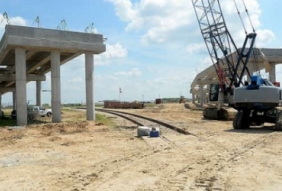
Posted on July 7, 2016
By Dan Wallach, beaumontenterprise
On the south side of Interstate 10 east of the Neches River, behind a thick line of trees, private industry is pouring millions into an expansion of an oil terminal and the state is building an overpass to jump over railroad tracks so workers and product can easily get in and out of the Port of Beaumont’s Orange County property.
The new skyway, paid for by the Texas Department of Transportation with an $8.9 million grant, connects Old U.S. 90 and the Port of Beaumont’s Orange County property and will support a $55 million expansion investment.
The joint venture of Jefferson Gulf Coast Energy Partners and Green Plains Inc., will build up to a total of 27 oil storage tanks on the port’s 243-acre property.
It also means industrial construction, which will employ all manner of skilled workers, including welders, one of the most in-demand crafts there is.
When both projects are completed in late 2017, oil storage capacity at the port’s Orange County property will be about 1 million barrels.
The “skyway” will improve access into the properties run by the port, by Jefferson Energy and for the Gerdau steel mill.
It also will ensure that longshoremen can get into the port quickly when a ship docks, which cuts costs by limiting delays if a train happens to be passing by.
One section of the skyway will head to the right, to the Jefferson area and one to the left, to the port’s dock, said Bill Carpenter, deputy port director.
The $55 million is for the first phase of planned development, Jeffereson and Green Plains said in a prepared statement.
While uncertainty about global trade is causing some countries to retreat from previous alliances, investment in Southeast Texas and southwestern Louisiana is speeding up.
Natgasoline, just south of Beaumont, will become a major methanol manufacturer with its $1 billion plant. Cheniere Energy is converting its Cameron Parish, Louisiana, terminal for liquefied natural gas for export at a contemplated overall price tag of $20 billion.
Motiva Port Arthur refinery spent $10 billion to become the larget refinery in the United States, and ExxonMobil is considering a major expansion to bring it into the same league with Motiva.
At the joint venture on the port’s property, further development is expected to add multiple liquid products for import and export, including liquid hydrocarbons, vegetable oils and other non-liquid commodities, according to a company announcement.
“Once completed, we believe this terminal will provide Green Plains and other customers with significant advantages over other locations,” said Todd Becker, president and chief executive of Green Plains.
“Access to three Class 1 railroads, barges and inbound-outbound vessels positions the terminal with transportation and cost advantages that will make this a successful partnership,” Becker said. “This terminal will be one of the most modern and efficient solutions in the U.S.”
Green Plains is a NASDAQ-listed company (GPRE).
Jefferson Gulf Coast Energy Partners is a subsidiary of Fortress Transportation and Infrastructure Investors LLC, a New York Stock Exchange-listed equity (FTAI).
Green Plains is one of the nation’s largest ethanol producers and traders. The Port of Beaumont terminal will give it access to worldwide markets, said Greg Binion, president and chief executive of Jefferson.
Chris Fisher, executive director of the Port of Beaumont, counts it as another coup for the port’s development of its Orange County side during the past 15 years.
“This joint venture will diversify the existing facility and complement the public-private partnership Jefferson enjoys with the Port of Beaumont. We expect it to be one of the most versatile ethanol hubs in the country and deliver additional economic benefit to the area,” he said.
Neither Jefferson nor Green Plains had a start date for construction or an estimate of how many would be employed in construction. The project is of the kind that requires trained welders, which Lamar Institute of Technology is working to supply for the area’s industrial needs.
The joint venture’s terminal will have direct access to multiple transportation options, including trucks; oceangoing medium-sized crude tankers, inland and coastal barges; and unit trains – with cars of up to 120 – with direct mainline service from the Union Pacific, BNSF and KCS railroads.





